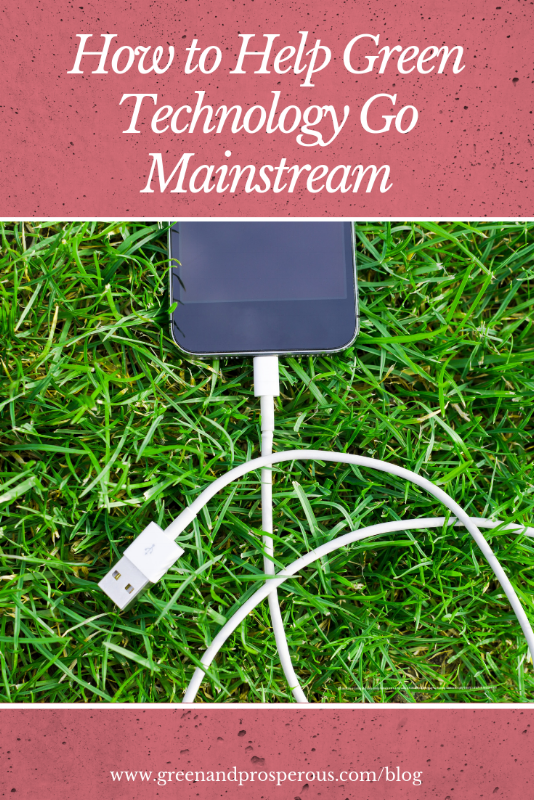How to Help Green Technology Go Mainstream
/guest post by Mersad
Green technology is the foundation of a sustainable economy. And yet, individuals and companies alike face problems going from research based prototypes to mainstream implementation. Getting green technology to push past market barriers, move beyond a research based idea and into mainstream markets is now the biggest problem facing the industry. Without it, benefits associated with green technology won’t reach the businesses and individuals who need it most. However, with the right framework and investment, efforts put into creating a green economy can be fruitful.
Stand for Change
There are many stakeholders involved in green technology. From inventors to leaders, all the way to policymakers, everyone has a role to play. The deployment of green technologies hinges on changes to company culture, policy, and principles among industrial and commercial settings.
So how can each stakeholder help green technology go mainstream? It all comes down to diction. Words are very powerful. They form the foundation of ideas, create presentations, and dictate policy. Paramount to the success of any push for green technology is diction. Whether you are presenting a new technology to a business in Morocco or to an individual consumer in India, you must be diligent about the words you select.
1. Speak to emotions
One of the many lessons taught to future leaders is to involve their employees in any and all ways possible. The reason for this involvement, especially at the ground level, is to elicit participation from all people. When individuals contribute personally to a decision or plan, they have a vested interest in seeing it through. Studies indicate that when employees contribute to a company decision, they will work harder to see it to fruition. Employees are more active, more concerned, and harder working.
The real reason behind this change is the personal stake that they have. When individuals feel they have a personal stake in something, they care more about it. The same is true of green technology; people won’t care about it unless they have a personal stake in it.
From a mailroom clerk to a CEO, no one gets up in the morning asking themselves how to make the world a little greener. They all worry about making a living, caring for their families, etc. That said, technological innovations need to resolve practical needs that contain emotional or social dimensions, otherwise they will never break through market barriers. Getting technology diffused relies upon those social and emotional dimensions.
Be careful about the words you choose when marketing to an individual. Carefully select turns of phrase that highlight an emotional dimension or a social aspect.
Instead of saying a new solar based LED lamp can offer light for five hours straight while simultaneously recharging a phone, marketing messages must communicate social and emotional impacts of the same technology. Business owners will respond to being able to stay open longer. Parents will respond in a positive way to their children being able to study longer because of this lamp. Green technology must solve a practical problem with either a social or emotional dimension to it.
2. Market green technologies
When talking to a larger company or government, be cognizant of the words you choose. How we market green technologies is changing and if you don’t change with it, you won’t be successful.
There is a right and wrong way to present new discoveries, new ideas, programs, technology, and more. To date, almost all major companies have shouldered their corporate social responsibility (CSR) projects to make their consumers and stakeholders happy. The right words may convey to customers efforts made on a CSR web page, or in a CSR bulletin.
While a powerful first step, one that successfully brought the necessity of green friendly initiatives to the board room of CEO’s, CFO’s, and CIO’s, it is no longer sufficient. Today, marketing a cause, an idea, or a product as a CSR initiative alone is ineffective. CSR initiatives are more of a background occurrence now, and background occurrences rarely see mainstream light, let alone mainstream funding.
Today, the right way to present any green technology is to market it as a tangible business driver, to carefully select words that convey how it can either make profits or save the company costs. Highlighting an environmental responsibility alone is insufficient. Highlighting that a specific green technology can save operational costs, utilize resources better, or create profit is much better.
3. Reduce Risk
What’s more, you need to highlight how green technologies reduce risk. Choose your words carefully as you explain that a demand exists for certain technologies. Where there is demand, a catalyst lies in wait. Bringing down risks associated with investment is important, and showing that there is an existing and unfulfilled demand can do just that. Bold ideas can make a serious impact by solving an existing product, doing something better, and reducing investment risk.
Overall, finding a successful way to bring green technologies into the mainstream market is urgent, to say the least. The benefits of these technologies will reach individuals and businesses alike if we choose the right words. Words can help us explain the incredible opportunities that green technologies can offer people, businesses, and the planet. The words we choose can help us to speak to people’s emotions.
Those who see a personal connection or are emotionally invested in a technology are more apt to support it. The right words help us market new technologies the right way. Companies that see technology as a real business driver are more apt to invest. Finally, the right words help us showcase reduced risk. Showing an existing demand and reduced risk for investors is paramount to the successful launch of green technologies into the mainstream marketplace.
4. Live a healthier and greener lifestyle
You might not realize it, but people are watching you. Perhaps not all the time, but people notice how you live your life. And, they will mimic some of your lifestyle choices. If you are seen recycling in public, it might inspire other people to do the same. If you frequent second hand stores to buy used goods, others might follow suit. If you shop for organic foods at your local grocery store (especially if you encourage others to do the same), this behavior encourages the company and/or producer to increase buying or production as they see the demand is rising.
If you opt to take a bus or ride your bike instead of driving your car, you are leading by example. And that is when the ripple effect occurs. You might be just one person, but advocating for and living a greener lifestyle affects the lives of those around you—this is true whether they are family members, friends, co-workers, acquaintances or even strangers. We’ve all seen other people do things we don’t and thought to ourselves that we should do the same. As a result, you are helping green lifestyles and the accompanying technologies behind them to go mainstream.
People want to use green technologies, they just want them to be valuable and convenient. They also want the business owner to show passion for the product. If you can’t convince yourself of its benefit, how can you convince anyone else?
Mersad runs the blog at Go Green (www.gogreen.org), an environmental news website that aims to highlight the biggest issues in sustainability, including corporate and tech initiatives, environmental activism, animal welfare, and everything in between.
Like this? Please pin!







































